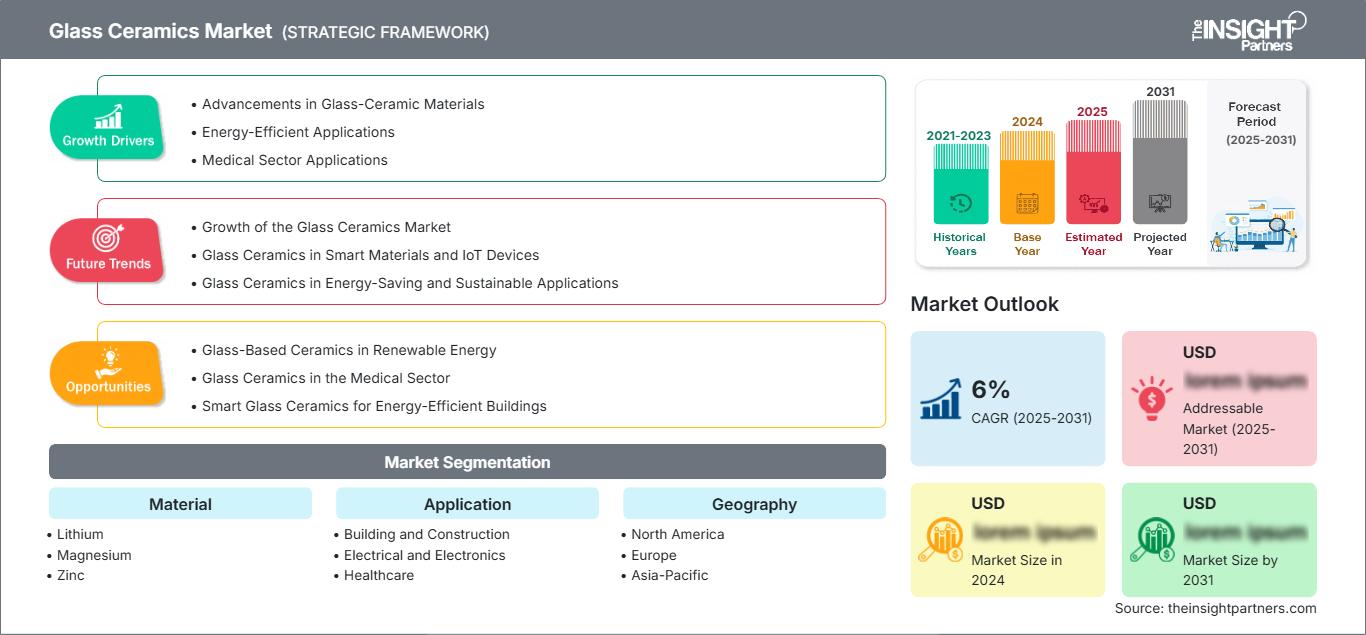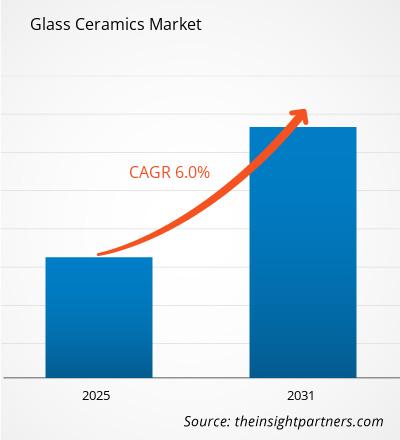预计玻璃陶瓷市场在 2025 年至 2031 年期间的复合年增长率为 6%,市场规模将从 2024 年的 XX 百万美元扩大到 2031 年的 XX 百万美元。
该报告按材料(锂、镁和锌)细分。全球分析进一步细分为区域和主要国家。该报告进一步根据应用(建筑和施工、电气和电子、医疗保健、航空航天、光学和其他应用)进行分析。全球分析进一步细分为区域和主要国家。该范围涵盖所有关键细分市场的全球、区域和国家层面的市场规模和预测。该报告以美元提供上述分析和细分的价值。该报告提供了主要市场参与者的市场状况关键统计数据,并揭示了市场趋势和机遇。
报告目的
Insight Partners 撰写的《玻璃陶瓷市场》报告旨在描述当前格局和未来增长、主要驱动因素、挑战和机遇。这将为各业务利益相关者提供见解,例如:
- 技术提供商/制造商:了解不断变化的市场动态并掌握潜在的增长机会,使他们能够做出明智的战略决策。
- 投资者:对市场增长率、市场财务预测以及整个价值链中存在的机遇进行全面的趋势分析。
- 监管机构:规范市场政策和警务活动,以最大程度地减少滥用,维护投资者的信任和信心,并维护市场的完整性和稳定性。
玻璃陶瓷市场细分材料
- 锂
- 镁
- 锌
应用
- 建筑与施工
- 电气与电子
- 医疗保健
- 航空航天
- 光学
- 其他应用
您将免费获得任何报告的定制,包括本报告的部分内容,或国家级分析、Excel 数据包,以及为初创企业和大学提供超值优惠和折扣
玻璃陶瓷市场: 战略洞察

-
获取本报告的主要市场趋势。这个免费样本将包括数据分析,从市场趋势到估计和预测。
玻璃陶瓷市场增长动力
- 玻璃陶瓷材料的进步:玻璃陶瓷生产模式和化学成分的变化正在加速市场的发展。例如,玻璃陶瓷材料已经开发出具有更高强度、耐高温和耐腐蚀性能的材料,并且它们的应用已经扩展到电子、航空工业和外科手术器械等新领域。
- 节能应用:玻璃陶瓷在对节能要求高的领域(例如烹饪盘和散热器)迅速得到应用。其保温和散热能力在住宅和商业用途中都得到了市场认可,同时也推动了环保节能解决方案的发展趋势。
- 医疗领域的应用:玻璃陶瓷技术的创新也正在应用于医疗领域,尤其是在设备植入物和成像系统中。玻璃陶瓷独特的生物相容性、强度以及可塑性使其在牙科植入物、手术器械和骨水泥等极端应用中非常有用。
玻璃陶瓷市场未来趋势
- 玻璃陶瓷市场的增长:玻璃陶瓷市场的增长可以归因于这些材料在量子计算、航空航天和精密医疗设备等先进技术中的应用日益广泛。它们拥有适用于高科技应用的理想机械、热学和电学性能,这鼓励了这些新兴行业的先进开发和进一步探索。
- 智能材料和物联网设备中的玻璃陶瓷:为了开发主要用于物联网 (IoT) 设备的智能材料,预计玻璃陶瓷将得到广泛应用。传感器、执行器和其他电子部件对极端条件的抵抗力要求很高,因此这种材料是先进互联设备不可或缺的材料。
- 玻璃陶瓷在节能和可持续应用中的应用:随着环保意识的不断增强,玻璃陶瓷在节能领域的应用将越来越广泛。玻璃陶瓷的热特性使其成为建筑、家电甚至工业领域中有效的节能材料。此外,其坚韧和可回收的特性完美契合了当前人们对可持续耐用材料关注的趋势。
玻璃陶瓷的市场机遇
- 玻璃基陶瓷在可再生能源中的应用:近年来,玻璃基陶瓷在可再生能源,尤其是太阳能和储能系统中的应用已变得至关重要。其高热稳定性、长寿命和绝缘性能使其在太阳能电池板、热电系统以及储热系统中非常有用,这在绿色能源领域具有巨大的潜力。
- 医疗领域的玻璃陶瓷:医疗领域对增强材料的需求日益增长,为玻璃陶瓷在生物活性植入物、牙冠和假肢的开发中创造了利基市场。玻璃陶瓷与人体组织的相容性、优异的强度、耐磨损和耐腐蚀性能,使其成为尖端医疗设备和健康解决方案的理想选择。
- 节能建筑的智能玻璃陶瓷:随着智能材料的普及,人们开始在生产玻璃陶瓷时融入适当的技术,例如改变颜色、热量或光线透射的技术。此外,由于智能窗户和节能建筑有助于提高建筑的舒适度和节能效果,因此对现代建筑和城市设计具有吸引力,因此对智能窗户和节能建筑的需求也呈现出积极的趋势。
玻璃陶瓷市场区域洞察
The Insight Partners 的分析师已详尽阐述了预测期内影响玻璃陶瓷市场的区域趋势和因素。本节还讨论了北美、欧洲、亚太地区、中东和非洲以及南美和中美洲的玻璃陶瓷市场细分和地域分布。
玻璃陶瓷市场报告范围
| 报告属性 | 细节 |
|---|---|
| 市场规模 2024 | US$ XX million |
| 市场规模 2031 | US$ XX Million |
| 全球复合年增长率 (2025 - 2031) | 6% |
| 历史数据 | 2021-2023 |
| 预测期 | 2025-2031 |
| 涵盖的领域 |
By 材料
|
| 覆盖地区和国家 |
北美
|
| 市场领导者和主要公司简介 |
|
玻璃陶瓷市场参与者密度:了解其对商业动态的影响
玻璃陶瓷市场正在快速增长,这得益于终端用户需求的不断增长,而这些需求的驱动因素包括消费者偏好的不断变化、技术进步以及对产品优势的认知度不断提高。随着需求的增长,企业正在扩大产品线,不断创新以满足消费者需求,并抓住新兴趋势,从而进一步推动市场增长。

- 获取 玻璃陶瓷市场 主要参与者概述
主要卖点
- 全面覆盖:本报告全面分析了玻璃陶瓷市场的产品、服务、类型和最终用户,提供了全面的市场格局。
- 专家分析:本报告基于对行业专家和分析师的深入了解而编写。
- 最新信息:本报告涵盖了最新信息和数据趋势,确保了其业务相关性。
- 定制选项:本报告可根据特定客户需求进行定制,并使其与业务战略完美契合。
因此,这份关于玻璃陶瓷市场的研究报告有助于引领解读和理解行业情景和增长前景的步伐。尽管可能存在一些合理的担忧,但本报告的总体优势往往大于劣势。
- 历史分析(2 年)、基准年、预测(7 年)及复合年增长率
- PEST和SWOT分析
- 市场规模、价值/数量 - 全球、区域、国家
- 行业和竞争格局
- Excel 数据集
近期报告
相关报告
客户评价
购买理由
- 明智的决策
- 了解市场动态
- 竞争分析
- 客户洞察
- 市场预测
- 风险规避
- 战略规划
- 投资论证
- 识别新兴市场
- 优化营销策略
- 提升运营效率
- 顺应监管趋势






















 获取免费样品 - 玻璃陶瓷市场
获取免费样品 - 玻璃陶瓷市场